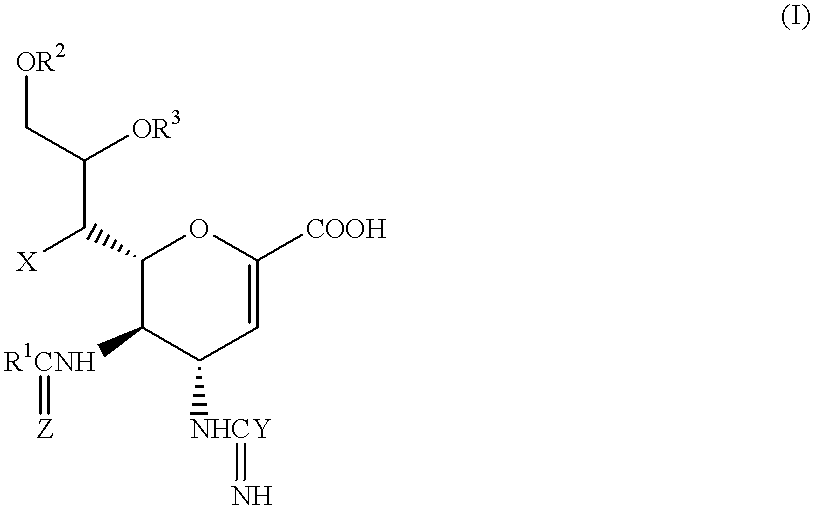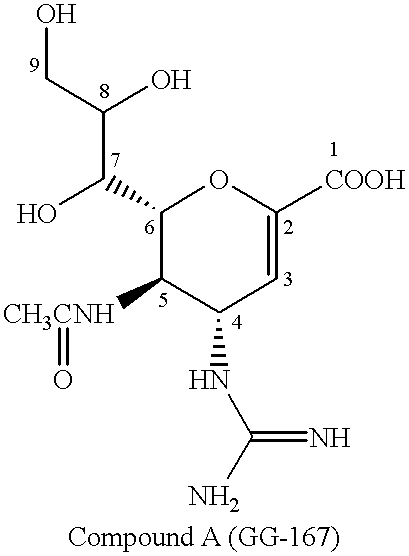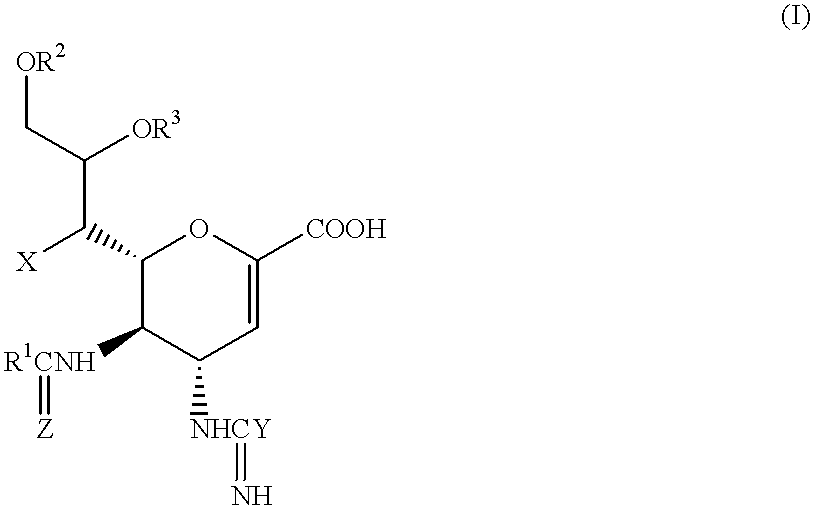Neuraminic acid derivatives, their preparation and their medical use
a technology of neuronal acid and derivatives, applied in the field of neuronal acid derivatives, can solve the problem of second-infection of surrounding cells
- Summary
- Abstract
- Description
- Claims
- Application Information
AI Technical Summary
Benefits of technology
Problems solved by technology
Method used
Image
Examples
example 2
5-Acetamido-4-(C-aminooxy-C-iminomethylamino)-2,3,4,5-tetradeoxy-D-glycero-D-galacto-non-2-enopyranosoic acid (Compound No. 34-1)
##STR20##
2(i) 5-Acetamido-4-(C-aminooxy-C-iminometbylamino)-2,3,4,5-tetradeox-D-glycero-D-galacto-non-2-enopyranosoic acid
20 mg (0.05 mmol) of 5-acetado-4-(C-aminooxy-C-iminomethylamino)-7-O-hexanoyl-2,3,4,5-tetradeoxy-D-glycero-D-galacto-non-2-enopyranosoic acid (prepared as described in Example 1) were dissolved in 20 ml of methanol, and 2.1 ml of a 4.9 M methanolic solution of sodium methoxide (0.01 mmol) were added to the resulting solution, while stirring at room temperature. The solution was then stirred at room temperature for a further 2 hours, after which a 4 M solution of hydrogen chloride in dioxane was added, to adjust the pH to a value of 6-7. The mixture was then evaporated to dryness under a vacuum. The resulting residue was applied to a silica gel chromatography column, using a 5:1:1 by volume mixture of isopropanol, ethyl acetate and water...
example 3
5-Acetamido-4-(C-aminooxy-C-iminomethylamino)-9-O-hexanoyl-2,3,4,5-tetradeox-D-glycrid-D-galacto-non-2-enopyranosic acid (Compound No. 3436)
##STR21##
3(i) 5-Acetamido-4-amino-9-O-hexanoyl-2,3,4,5-tetradeoxy-D-glycero-D-galacto-non-2-enopyranosoic acid
80 mg (0.21 mmol) of 5-acetamido-4-amino-7-O-hexanoyl-2,3,4,5-tetradeoxy-D-glycero-D-galacto-non-2-enopyranosoic acid [prepared as described in Example 1 (vi)] were dissolved in a mixture of 3 ml of trifluoroacetic acid and 6 ml of methylene chloride at room temperature, and the mixture was then stirred at room temperature for a further 6 hours. At the end of this time, the solvent was removed by distillation under reduced pressure to obtain a residue. This residue was subjected to azeotropic distillation with benzene, after which it was evaporated to dryness under a vacuum. The resulting residue was then subjected to silica gel column chromatography, using a 2:5:1 by volume mixture of isopropanol, ethyl acetate and water as the eluent, ...
example 4
5-Acetamido-4-(C-aminooxy-C-iminomethylamino)-7-O-tetradecanoyl-2,3,4,5-tetradeoxy-D-glycero-D-galacto-non-2-enopyranosoic acid (Compound No. 1061)
##STR22##
4(i) Methyl 5-acetamidoazido-7-O-tetradecanoyl-8,9-O-isopropyliden-2,3,4,5-tetradeoxy-D-glycer-D-galacto-non-2-enopyranosoate
1.50 g (4.05 mmol) of methyl 5-acetamido 4azido-8,9-O-isopropylidene-2,3,4,5-tetradeoxy-D-glycero-D-galacto-non-2-enopyranosoate [prepared as described in Example 1(ii)] were dissolved in 30 ml of methylene chloride, and 545 mg (4.45 mmol) of dimethylaminopyridine and 1.32 ml (4.86 mmol) of tetradecanoyl chloride were added to the resulting solution, while stirring in an ice bath. The reaction mixture was then stirred at room temperature for 40 minutes, after which 0.62 ml (4.45 mmol) of triethylamine was added dropwise to the mixture in an ice bath. The mixture was then stirred at room temperature for 20 hours. At the end of this time, 200 ml of ethyl acetate and 100 ml of a saturated aqueous solution of s...
PUM
| Property | Measurement | Unit |
|---|---|---|
| temperature | aaaaa | aaaaa |
| temperature | aaaaa | aaaaa |
| temperature | aaaaa | aaaaa |
Abstract
Description
Claims
Application Information
 Login to View More
Login to View More - R&D
- Intellectual Property
- Life Sciences
- Materials
- Tech Scout
- Unparalleled Data Quality
- Higher Quality Content
- 60% Fewer Hallucinations
Browse by: Latest US Patents, China's latest patents, Technical Efficacy Thesaurus, Application Domain, Technology Topic, Popular Technical Reports.
© 2025 PatSnap. All rights reserved.Legal|Privacy policy|Modern Slavery Act Transparency Statement|Sitemap|About US| Contact US: help@patsnap.com



